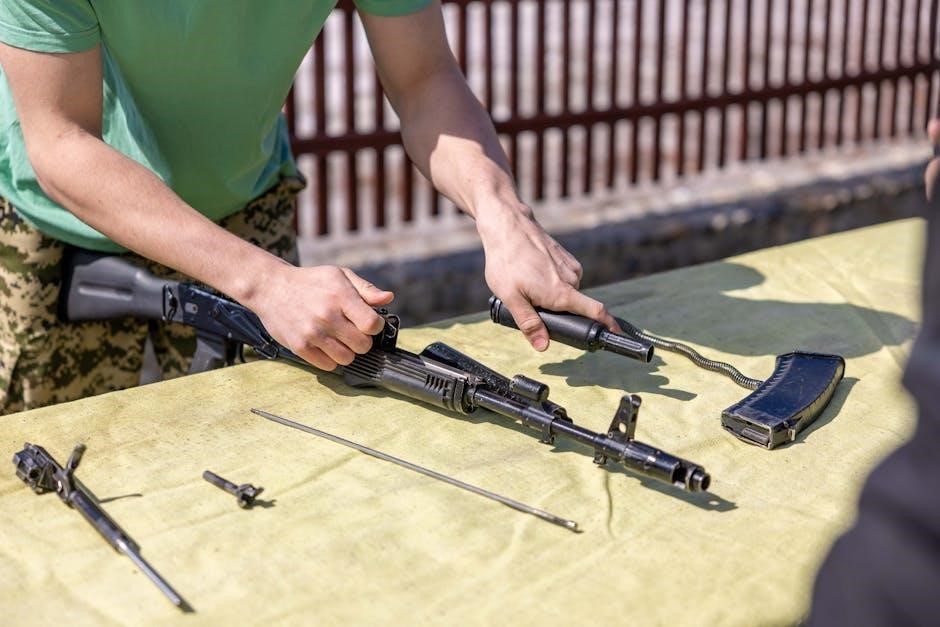This manual provides comprehensive instructions for operating your Presto pressure canner, ensuring safe and effective food preservation. It covers everything from initial setup to troubleshooting. You’ll find detailed guidance on pressure canning techniques and necessary precautions to follow. Consult this manual for all your canning needs.
Overview of Presto Pressure Canner Models
Presto offers a range of pressure canner models designed to meet diverse canning needs. These models vary in size, material, and features, catering to both novice and experienced canners. Among the popular options are the aluminum pressure canners, known for their even heat distribution and affordability. These canners come in various quart capacities, such as 16-quart and 23-quart, accommodating different batch sizes.
For those seeking advanced features, Presto also offers digital pressure canners. These models incorporate electronic controls for precise pressure and time management, taking the guesswork out of canning. The Presto Precise digital canner, for example, is uniquely designed for pressure canning with pre-programmed settings.
Selecting the right model depends on factors like the volume of food you typically can, your budget, and your desired level of automation. Whether you opt for a classic aluminum canner or a modern digital version, Presto pressure canners are built to provide safe and reliable performance. Always consult the specific model’s instruction manual for detailed information and usage guidelines.
Key Components and Their Functions

Understanding the key components of your Presto pressure canner is crucial for safe and effective operation. The canner body, typically made of aluminum, holds the jars and water, with its size determining the batch capacity. The lid, secured with a locking mechanism, creates a tight seal to build pressure inside the canner. A crucial safety feature is the overpressure plug, designed to release excess pressure if it exceeds safe levels.
The pressure regulator, or weight, maintains the desired pressure during processing. Different weights correspond to specific pressure settings, often 5, 10, or 15 PSI. A vent pipe allows air to escape during the initial heating phase, ensuring proper pressure buildup. The sealing ring, located inside the lid, creates an airtight seal between the lid and the canner body.
Inside the canner, a canning rack elevates the jars above the bottom, allowing hot water to circulate evenly. Together, these components work in harmony to create a safe and controlled environment for pressure canning. Regular inspection and maintenance of each part are essential to ensure proper functionality and prevent accidents. Refer to your Presto pressure canner manual for detailed diagrams and specific information.
Safety Precautions for Pressure Canning
Pressure canning requires strict adherence to safety precautions to prevent accidents and ensure food safety. Always follow the manufacturer’s instructions in your Presto pressure canner manual. Before each use, inspect all components, including the sealing ring, vent pipe, and overpressure plug, for any damage or wear. Never attempt to force the lid closed or open it while the canner is pressurized.
Ensure that the vent pipe is clear of obstructions before starting the canning process. Use only tested recipes from reputable sources like the USDA or university extension services, as incorrect processing times can lead to spoilage and botulism. Avoid overfilling the jars, and maintain the correct headspace as specified in the recipe. When lowering jars into the canner, use a jar lifter to prevent burns.
During processing, monitor the pressure gauge or weighted regulator to maintain the correct pressure. Never leave the canner unattended. Once processing is complete, allow the pressure to drop naturally before opening the lid. Do not attempt to cool the canner quickly, as this can cause food spoilage. Store canned goods in a cool, dark, and dry place, and always check for signs of spoilage before consumption.
Step-by-Step Pressure Canning Instructions
Begin by thoroughly washing and preparing your jars and lids according to the manufacturer’s instructions. Select a tested recipe from a reliable source, ensuring accurate measurements and ingredients. Prepare the food according to the recipe, heating it as directed. Fill the jars, leaving the recommended headspace, and remove any air bubbles using a non-metallic utensil. Wipe the jar rims clean and place the lids and rings on securely.
Add the specified amount of water to the Presto pressure canner, following the manual’s guidelines for your specific model. Place the filled jars inside the canner using a jar lifter, ensuring they do not touch each other or the sides of the canner. Secure the canner lid, following the instructions for proper alignment and locking. Turn the heat to high and vent the canner for the specified time to remove air.
After venting, close the vent pipe or place the weighted regulator on the vent. Monitor the pressure gauge and maintain the recommended pressure for the processing time specified in your recipe. Once processing is complete, turn off the heat and allow the pressure to drop naturally. Carefully remove the jars, place them on a towel-lined surface, and let them cool completely before checking the seals.
Water Level and Preparation
Proper water level is crucial for safe and effective pressure canning. Always consult your Presto pressure canner’s instruction manual for the specific water level required for your model. Typically, this involves adding a specified amount of water to the canner before placing the filled jars inside. The water level ensures adequate steam production, which is essential for reaching the correct pressure and maintaining a consistent temperature throughout the canning process.
Before adding water, inspect the canner for any signs of damage, such as cracks or dents. Ensure the sealing ring is clean and properly seated. The water used should be clean and potable. In some cases, hard water can leave mineral deposits inside the canner, so using filtered water may be beneficial. Always measure the water accurately using a measuring cup or pitcher.
The water level should be sufficient to prevent the jars from boiling dry during processing. However, it should not be so high that it interferes with the venting process or causes water to splash onto the jars during pressure release. Refer to your manual for the recommended water level based on the type and size of jars you are using. Accurate water level ensures safe and proper canning.
Processing Times and Pressure Settings
Accurate processing times and pressure settings are paramount for safe and successful pressure canning. These parameters are determined by several factors, including the type of food being canned, the size of the jars, and your altitude. Always consult a reliable source, such as the USDA Complete Guide to Home Canning or your Presto pressure canner’s instruction manual, for recommended processing times and pressure settings.
Using incorrect processing times or pressure settings can lead to inadequate heat penetration, which may result in spoilage and potentially dangerous toxins. Processing times vary depending on whether you are canning low-acid foods like vegetables, meats, or poultry, or high-acid foods like fruits and pickles. Low-acid foods require higher temperatures and longer processing times to eliminate harmful bacteria.
Altitude also plays a crucial role in determining the correct pressure setting. At higher altitudes, water boils at a lower temperature, so you must increase the pressure to achieve the necessary processing temperature. Your Presto manual will provide altitude adjustment charts to help you determine the appropriate pressure setting for your location. Always adhere to these guidelines to ensure food safety.
Troubleshooting Common Issues
Even with careful preparation, issues may arise during the pressure canning process. Understanding common problems and their solutions can help you ensure successful and safe canning. One frequent concern is the failure of the canner to reach the desired pressure. This can be due to several factors, including an insufficient heat source, a worn-out sealing ring, or a clogged vent pipe.
Before each use, inspect the sealing ring for cracks or damage and replace it if necessary. Ensure the vent pipe is clear of any obstructions to allow proper steam release. Another common issue is water leaking from the canner during processing. This may indicate that the lid is not properly sealed or that the canner is overfilled. Make sure the lid is securely locked and the water level is below the maximum fill line.
Sometimes, jars may break during or after processing. This can be caused by using jars with chips or cracks, sudden temperature changes, or improper venting. Always inspect jars for damage before filling and avoid placing hot jars on cold surfaces. If you encounter persistent problems, consult your Presto pressure canner’s instruction manual for specific troubleshooting steps or contact Presto’s customer support for assistance.

Cleaning and Maintenance
Proper cleaning and maintenance are crucial for ensuring the longevity and safe operation of your Presto pressure canner. After each use, allow the canner to cool completely before disassembling and cleaning it. Wash the canner body and lid with warm, soapy water, using a non-abrasive sponge or cloth to avoid scratching the surface. Rinse thoroughly and dry completely before storing.
Pay special attention to cleaning the sealing ring and vent pipe, as food particles can accumulate in these areas and affect the canner’s performance. Remove the sealing ring and wash it separately, inspecting it for any signs of wear or damage. Clean the vent pipe with a small brush or pipe cleaner to ensure it is free from obstructions.
The overpressure plug should also be inspected and cleaned regularly. Check for any cracks or deterioration and replace it if necessary. When storing your pressure canner, make sure it is completely dry to prevent rust or corrosion. Store the lid upside down on the canner body to allow air circulation. With regular cleaning and maintenance, your Presto pressure canner will provide years of reliable service.

Contacting Presto for Support and Parts
If you encounter any issues with your Presto pressure canner or require replacement parts, Presto offers several avenues for support. Their customer service team is available to assist with troubleshooting, provide guidance on proper usage, and answer any questions you may have about your canner. You can reach them by phone, email, or through their website.
For immediate assistance, calling their toll-free number is often the quickest way to get help. Be sure to have your canner’s model number and date of purchase handy when you call. If you prefer to communicate in writing, you can send an email detailing your issue or question. Presto also has a comprehensive website with FAQs, troubleshooting guides, and other helpful resources.
If you need to order replacement parts, such as sealing rings, overpressure plugs, or pressure regulators, you can do so through Presto’s website or by contacting their customer service department. They offer a wide range of genuine Presto parts to ensure the continued safe and efficient operation of your canner. Don’t hesitate to reach out to Presto for any support or parts you may need.


